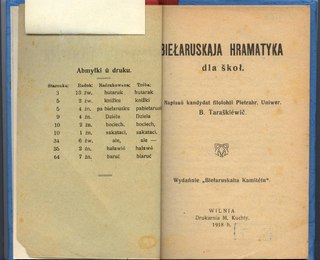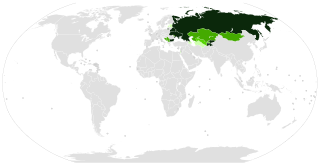
Belarusian is an East Slavic language. It is one of the two official languages in Belarus, alongside Russian. Additionally, it is spoken in some parts of Russia, Lithuania, Latvia, Poland, and Ukraine by Belarusian minorities in those countries.

The Russian alphabet is the script used to write the Russian language. It comes from the Cyrillic script, which was devised in the 9th century for the first Slavic literary language, Old Slavonic. Initially an old variant of the Bulgarian alphabet, it became used in the Kievan Rusʹ since the 10th century to write what would become the modern Russian language.

The Belarusian Latin alphabet or Łacinka for the Latin script in general is the common name for writing Belarusian using Latin script. It is similar to the Sorbian alphabet and incorporates features of the Polish and Czech alphabets. Today, Belarusian most commonly uses the Cyrillic alphabet.

Kalmyk Oirat, commonly known as the Kalmyk language, is a variety of the Oirat language, natively spoken by the Kalmyk people of Kalmykia, a federal subject of Russia. In Russia, it is the standard form of the Oirat language, which belongs to the Mongolic language family. The Kalmyk people of the Northwest Caspian Sea of Russia claim descent from the Oirats from Eurasia, who have also historically settled in Mongolia and Northwest China. According to UNESCO, the language is "Definitely endangered". According to the Russian census of 2021, there are 110,000 speakers of an ethnic population consisting of 178,000 people.

I is a letter used in almost all Cyrillic alphabets with the exception of Belarusian.

The Bulgarian Cyrillic alphabet is used to write the Bulgarian language. The Cyrillic alphabet was originally developed in the First Bulgarian Empire during the 9th – 10th century AD at the Preslav Literary School.

Yeru or Eru, usually called Y in modern Russian or Yery or Ery historically and in modern Church Slavonic, is a letter in the Cyrillic script. It represents the close central unrounded vowel after non-palatalised (hard) consonants in the Belarusian and Russian alphabets, and after any consonant in most of Rusyn standards, where it represents the unrounded close-mid back unrounded vowel sound.

The Ukrainian alphabet is the set of letters used to write Ukrainian, which is the official language of Ukraine. It is one of several national variations of the Cyrillic script. It comes from the Cyrillic script, which was devised in the 9th century for the first Slavic literary language, called Old Slavonic. In the 10th century, it became used in Kievan Rus' to write Old East Slavic, from which the Belarusian, Russian, Rusyn, and Ukrainian alphabets later evolved. The modern Ukrainian alphabet has 33 letters in total: 21 consonants, 1 semivowel, 10 vowels and 1 palatalization sign. Sometimes the apostrophe (') is also included, which has a phonetic meaning and is a mandatory sign in writing, but is not considered as a letter and is not included in the alphabet.

Short U or U with breve is a letter of the Cyrillic script. The only Slavic language using the letter in its orthography is Belarusian, but it is also used as a phonetic symbol in some Russian and Ukrainian dictionaries. Among the non-Slavic languages using Cyrillic alphabets, ў is used in Dungan, Karakalpak, Karachay-Balkar, Mansi, Sakhalin Nivkh, Ossetian and Siberian Yupik. It is also used in Uzbek – this letter corresponds to Oʻ in the Uzbek Latin alphabet.

The Belarusian Arabic alphabet or Belarusian Arabitsa was based on the Arabic script and was developed in the 16th century. It consisted of twenty-eight graphemes, including several additions to represent Belarusian phonemes not found in the Arabic language.
The Russian Latin alphabet is the common name for various variants of writing the Russian language by means of the Latin alphabet.

There are 4 stages in the history of Yakut writing systems:

Numerous Cyrillic alphabets are based on the Cyrillic script. The early Cyrillic alphabet was developed in the 9th century AD and replaced the earlier Glagolitic script developed by the Bulgarian theologians Cyril and Methodius. It is the basis of alphabets used in various languages, past and present, Slavic origin, and non-Slavic languages influenced by Russian. As of 2011, around 252 million people in Eurasia use it as the official alphabet for their national languages. About half of them are in Russia. Cyrillic is one of the most-used writing systems in the world. The creator is Saint Clement of Ohrid from the Preslav literary school in the First Bulgarian Empire.
The cyrillization of Chinese is the transcription of Chinese characters into the Cyrillic alphabet.
The Cyrillic script family contains many specially treated two-letter combinations, or digraphs, but few of these are used in Slavic languages. In a few alphabets, trigraphs and even the occasional tetragraph or pentagraph are used.
JCUKEN is the main Cyrillic keyboard layout for the Russian language in computers and typewriters. Earlier in Russia JIUKEN (ЙІУКЕН) layout was the main layout, but it was replaced by JCUKEN when the Russian alphabet reform of 1917 removed the letters Ѣ, І, Ѵ, and Ѳ. The letter Ъ had decreased in usage significantly after the reform.
The Komi language, a Uralic language spoken in the north-eastern part of European Russia, has been written in several different alphabets. Currently, Komi writing uses letters from the Cyrillic script. There have been five distinct stages in the history of Komi writing:
Since its inception in the 18th century and up to the present, it is based on the Cyrillic alphabet to write the Udmurt language. Attempts were also made to use the Latin alphabet to write the Udmurt language. In its modern form, the Udmurt alphabet was approved in 1937.
Mordvinic alphabets is a writing system used to write Mordovian languages. From its inception in the 18th century to the present, it has been based on the Cyrillic alphabet. Until the beginning of the 20th century, the alphabet did not have a stable norm and was often changed. The modern alphabet has been in operation since the late 1920s.
Khakass alphabets are the alphabets used to write the Khakas language.













